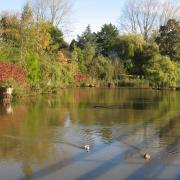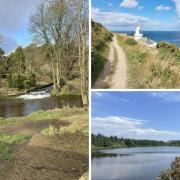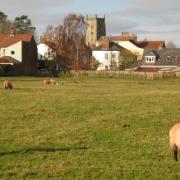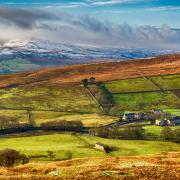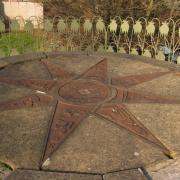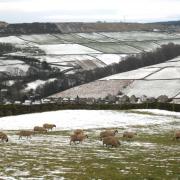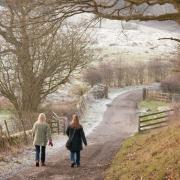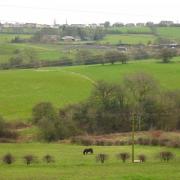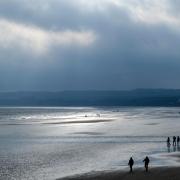Few stretches of coastline beat Scarborough to Saltburn for variety. There's even a resort-that-never-was. John Woodcock reports PHOTOGRAPHS BY ANDY BULMER
If geography, geology and the climate had been kinder, and not crushed the fantasies of a group of businessmen, Pat and Gary Mollon's summer season could have been very different from the one they're experiencing. It would be more in keeping with the clamour of Scarborough, the couple's home town.
Instead, 10 miles away, they're catering at the end of a clifftop cul-de-sac for those who escape the beaten path. Greetings from the remnants of Yorkshire's lost resort.
At the turn of the last century there were those who believed that the former industrial settlement of Peak could be transformed into a seaside destination to rival any along the coast. Why not? The setting is sublime, at least on a fine day, and the recentlyopened railway would bring the customers. The visionaries changed Peak's name to Ravenscar, a map of the proposed town was drawn, and a brickworks established to build it.
The Mollons' tearoom is in the former hotel where would-be investors were wined and dined and in several cases persuaded to become pioneers. Dreamers and fools more like. The venture foundered on the rocks beneath Ravenscar's 400ft headland, in part because there was no beach, a fact which seems to have been overlooked by the Ravenscar Development Company.
It was declared bankrupt in 1911, leaving behind a scattering of houses and the outlines of thoroughfares which were to have had names like Marine Esplanade. The resort-that-never-was, despite its magnificent view of Robin Hood's Bay, is another example of man's folly; a follythat attracts the curio branch of tourism, and for the Mollons only sufficient business to justify being open for light snacks from Easter to October.
A glimpse of what might have been arrived one day in their caf� in Station Square, a misnomer now because the Scarborough-Whitby line closed 44 years ago.
Mr Mollon explained: 'A lady came in and unrolled some deeds which she said had belonged to her great grandfather. She seemed to think she owned a house here, and I had to explain that she'd be sharing the plot with sheep. The house in question was one of many that were planned but never built. As a holiday resort Ravenscar exists only on old marketing posters, postcards, and my fridge magnets.'
The magnet which draws the hordes is across Robin Hood's Bay, and itsnamesake's tumbling ginnels splashed with the colours of tight-packed cottages. By way of consolation for Ravenscar, a couple of popular hiking routes lead there. It's one end of the Lyke Wake Walk, and is on the Cleveland Way, which has reached a milestone of its own - this is its 40th year as a national trail.
By chance, other significant anniversaries are being marked along part of its route, two of them in Whitby, now almost overwhelmed by its popularity. It's the 50th birthday of the Sutcliffe Gallery, which pays tribute to the work of the photographer Frank Meadow Sutcliffe.
He set up a studio in a disused jet workshop in 1875 and with plate cameras constructed from brass and mahogany began recording the lives and times of Whitby, Sandsend, Staithes, and neighbouring communities. He produced a unique archive of 1,600 images, and about 200, previously unseen by the public, have been restored to coincide with the gallery's special year.
In many Whitby scenes Sutcliffe could hardly have avoided the swing bridge over the Esk which links the east and west cliff, and separates the upper and lower harbour. A series of events this summer beginning on August 21st will celebrate the bridge's centenary. As one of the organisers puts it: 'She is a grand old lady with a few aches and pains, but she's bound to be on her best behaviour.'
There's more modest continuity in one of the loveliest of settings. If you've been to Runswick Bay any time but winter, you've probably called at the Sandside Caf�. That won't mean a thing to most because this is a caf� and shop which doesn't reveal its name in public, but displays everything else for a traditional day by the sea: beach balls, shrimping nets, model boats, paper flags for the castles you can build with their buckets and spades, rubber rings and dinghies, windbreaks, bags of mixed sweets, ice creams, and lemon drizzle cake.
The formula has change little since William Cole and his wife Patricia took over the business 50 years ago - 'or is it 51, or even 53?' pondered their daughter Anna, who now runs the establishment with her brother Richard and his wife Brenda.
They maintain a simple philosophy, says Anna: 'Mum used to say she wanted to create a place which children would remember with affection and return to with their children, and so on through the generations.We try to provide a timeless atmosphere. Grownups are delighted to discover that some things don't change too much.'
The coastline itself in this area has seen dramatic changes over the centuries. Not only local hero Captain James Cook made world-changing discoveries. Looking down on the forlorn remains of its tiny harbour, try and imagine how Port Mulgrave once helped to power the Industrial Revolution and British Empire. In the mid-19th century they mined ironstone here and sent to furnaces the raw material that was building the first railways and a new kind of ship.
The site is now owned by the National Trust, and the wider story of the region's ironstone industry, where 80 mines between them produced nearly seven million tons annually, is told at the Cleveland Ironstone Mining Museum at Skinningrove.
On the way, just after Staithes, you'll pass Boulby, a place where they're still mining - potash now - and whilst they're at it, providing an environment which is helping scientists explore the mysteries of the universe more than 3,600ft underground. Conditions down there create an ideal laboratory in the quest for 'dark matter', one of the fundamentals of the cosmos, and almost impossible to detect among all the distractions on the Earth's surface.
From Skinningrove the Cleveland Way almost tumbles over towering cliffs to reach our journey's end, Saltburn-by-the-Sea. The scene from the heights is of striking contrasts: Roseberry Topping and the Cleveland Hills, the industrial billows of Teesside, an anchorage for world shipping, and, below, Saltburn's finest assets.
A Victorian cliff lift - probably the world's oldest using water-power technology - reaches one of the best beaches in Britain, and Yorkshire's only pleasure pier. Not just any pier but the last in the North to survive on the East Coast. Yet another anniversary - it opened 140 years ago and endured many batterings before being restored and shortened in the 1990s.
In the old days, passenger steamers called at the pier head on voyages between Hartlepool and Scarborough and Bridlington. Alternatively, you could take the train which wound along most of the coastline.
Today's transport options are fewer, but however you arrive rejoice at our seaside in all its incredible diversity.



